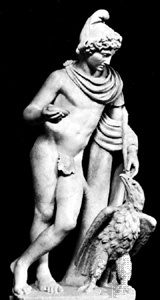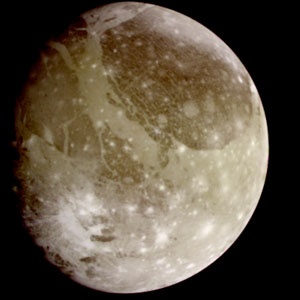Ganymede
Greek mythology
Greek Ganymēdēs, Latin Ganymedes, or Catamitus,
 in Greek legend, the son of Tros (or Laomedon), king of Troy. Because of his unusual beauty, he was carried off either by the gods or by Zeus, disguised as an eagle, or, according to a Cretan account, by Minos, to serve as cupbearer. In compensation, Zeus gave Ganymede's father a stud of immortal horses (or a golden vine). The earliest forms of the myth have no erotic content, but by the 5th century BC it was believed that Ganymede's kidnapper had a homosexual passion for him; Ganymede's kidnapping was a popular topic on 5th-century Attic vases. The English word catamite was derived from the popular Latin form of his name. He was later identified with the constellation Aquarius.
in Greek legend, the son of Tros (or Laomedon), king of Troy. Because of his unusual beauty, he was carried off either by the gods or by Zeus, disguised as an eagle, or, according to a Cretan account, by Minos, to serve as cupbearer. In compensation, Zeus gave Ganymede's father a stud of immortal horses (or a golden vine). The earliest forms of the myth have no erotic content, but by the 5th century BC it was believed that Ganymede's kidnapper had a homosexual passion for him; Ganymede's kidnapping was a popular topic on 5th-century Attic vases. The English word catamite was derived from the popular Latin form of his name. He was later identified with the constellation Aquarius.satellite of Jupiter
also called Jupiter III
 largest of Jupiter's satellites and of all the satellites in the solar system. One of the Galilean moons, it was discovered by the Italian astronomer Galileo in 1610. It was probably also discovered independently that same year by the German astronomer Simon Marius (Marius, Simon), who named it after Ganymede of Greek mythology.
largest of Jupiter's satellites and of all the satellites in the solar system. One of the Galilean moons, it was discovered by the Italian astronomer Galileo in 1610. It was probably also discovered independently that same year by the German astronomer Simon Marius (Marius, Simon), who named it after Ganymede of Greek mythology.Ganymede has a diameter of about 5,270 km (3,275 miles), which makes it larger than the planet Mercury. It orbits Jupiter at a distance of 1,070,000 km (665,000 miles). Ganymede's relatively low density of 1.93 grams per cubic cm indicates that its composition is roughly half rock and half water ice by mass. Spacecraft investigations of its gravity field reveal that the interior consists of a dense, iron-rich core with a radius of 1,500 km (930 miles) surrounded by a rocky lower mantle, which is wrapped with a layer of ice some 700 km (430 miles) thick. The iron core produces a magnetic field that is 1 percent as strong as Earth's.
Ganymede was observed at close range in 1979 by the Voyager 1 and 2 spacecraft and by the Galileo orbiter beginning in the mid-1990s. Previously, in addition to water ice, spectroscopic observations of Ganymede from Earth had detected molecular oxygen and ozone trapped in the ice. Spectra obtained by Galileo's instruments showed evidence for hydrated minerals resembling clays; solid carbon dioxide; traces of hydrogen peroxide probably produced from the ice by photochemical reactions; sulfur compounds, some of which may have come from Jupiter's volcanically active satellite Io; and organic material that may have been deposited by impacting comets. The polar regions are lightly frosted with fresh ice and are crowned by flickering auroras (aurora) produced by subatomic particles following the satellite's magnetic field lines.
 The surface comprises two principal types of terrain, one dark and one bright. The dark terrain is present in broad, roughly polygonal regions that are separated by bands of bright terrain. Both terrains have impact craters (meteorite crater). The density of craters is higher in the dark terrain, indicating that it is the older of the two types. Craters of a given diameter on Ganymede are generally much shallower than comparably sized craters on rocky bodies like the Moon or Mercury, suggesting that they have become partially filled in through cold viscous flow of the icy crust.
The surface comprises two principal types of terrain, one dark and one bright. The dark terrain is present in broad, roughly polygonal regions that are separated by bands of bright terrain. Both terrains have impact craters (meteorite crater). The density of craters is higher in the dark terrain, indicating that it is the older of the two types. Craters of a given diameter on Ganymede are generally much shallower than comparably sized craters on rocky bodies like the Moon or Mercury, suggesting that they have become partially filled in through cold viscous flow of the icy crust.The bright terrain is covered with complex patterns of long narrow grooves. The grooves are typically several hundred metres deep and may be hundreds of kilometres in extent. They often lie in parallel sets, with adjacent grooves spaced about 5–10 km (3–6 miles) apart. The bright terrain in the grooves probably formed during a period of tectonic activity in which internally generated stresses disrupted and fractured the crust. The exact time at which this activity occurred is not known, but the density of craters in the bright terrain suggests that it was early in Ganymede's history. That history must have included some intense internal heating in order to produce the internal differentiation into the metallic core and rock and ice layers that are observed today. The best current hypothesis for the necessary source of energy is a form of tidal heating ultimately driven by Jupiter's gravitational field.
- Charles Town
- Charlestown
- Charles Townsend Copeland
- Charles Townshend
- Charles Townshend, 2nd Viscount Townshend
- Charles Townshend Townshend, 2nd Viscount
- Charles T. Vinci
- Charles Tyson Yerkes
- Charles University
- Charles V
- Charles Valentine Riley
- Charles Van Lerberghe
- Charles VI
- Charles-Victor Langlois
- Charles VII
- Charles VIII
- Charles VIII Knutsson
- Charles Vildrac
- Charles Wakefield Cadman
- Charles Warren Fairbanks
- Charles Watson-Wentworth, 2nd marquess of Rockingham
- Charles Watson-Wentworth Rockingham, 2nd marquess of
- Charles W. Chesnutt
- Charles Weidman
- Charles Wesley